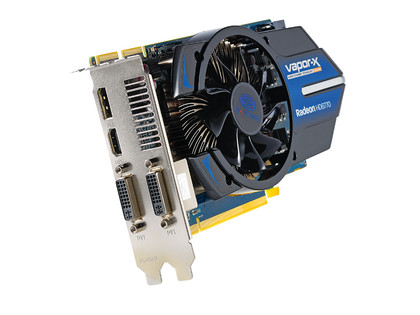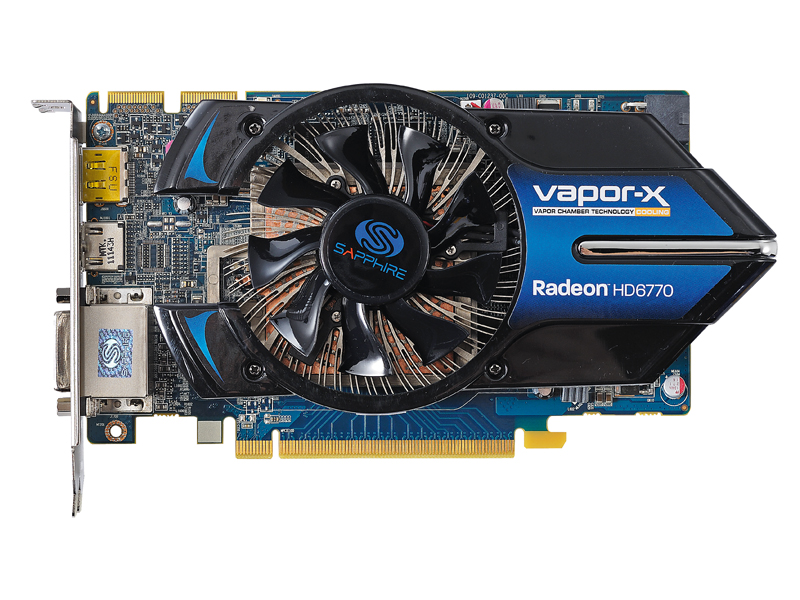TechRadar Verdict
Pros
- +
Decent price
- +
Performs like an HD 5770
Cons
- -
Essentially is a HD 5770
- -
High power draw
Why you can trust TechRadar
As much as we've railed against Nvidia in recent times for confusingly re-branding graphics cards and GPUs with newer series numbers without changing silicon, AMD is not averse to the practice either. The simple fact is there is almost no difference between its HD 6770 Vapor-X and the old school HD 5770.
Nvidia has done this before, re-badging the excellent 8800GTX multiple times, each vaguely dulling that excellence as it emerged. First it became the 9800GTX and then later the GTS 250, with very little modification.
Almost the same has happened here with the HD 6770 coming out with the exact same silicon onboard, in fact AMD almost seemed a little sheepish about the launch of this card and didn't really seem to make any noise about it at all.
Despite the 6-series naming update for the card though vendors don't seem to be asking for any more than the standard new HD 5770s still in the marketplace.
Though realistically it's going to kill any second-hand market of the HD 5770 as most people will automatically assume that the card with the higher number is going to be the faster chip.
If you look at the specs of both the Sapphire HD 6770 and XFX HD 5770 there is almost no difference at all.
They're both running the same Juniper GPU, with the same graphics core configuration. The only slight change on this VaporX version is that the HD 6770 here is running slightly overclocked at 860MHz versus the HD 5770's 850MHz.
Sign up for breaking news, reviews, opinion, top tech deals, and more.

TechRadar Labs

Thermal performance
100% Load: Degrees Centigrade: Lower is better
Sapphire HD 6770 Vapor-X: 64
XFX HD 5770: 73
DirectX 11 tessellation performance (2,560 x 1,600)
Heaven 2.5 Frames Per Second: Higher is better
Sapphire HD 6770 Vapor-X: 7.9
XFX HD 5770: 7.9
DirectX 11 gaming performance (1,920 x 1,080)
Shogun 2 Frames Per Second: Higher is better
Sapphire HD 6770 Vapor-X: 26
XFX HD 5770: 26
Power performance
100% Load Watts: Lower is better
Sapphire HD 6770 Vapor-X: 205
XFX HD 5770: 188
DirectX 11 gaming performance (1,680 x 1,050)
DiRT 3 Frames Per Second: Higher is better
Sapphire HD 6770 Vapor-X: 40
XFX HD 5770: 40
DirectX 11 gaming performance (1,680 x 1,050)
Metro 2033 Frames Per Second: Higher is better
Sapphire HD 6770 Vapor-X: 14
XFX HD 5770: 14
DirectX 10 gaming performance (1,680 x 1,050)
Just Cause 2 Frames Per Second: Higher is better
Sapphire HD 6770 Vapor-X: 30
XFX HD 5770: 29
DirectX 10 gaming performance (1,680 x 1,050)
Far Cry 2 Frames Per Second: Higher is better
Sapphire HD 6770 Vapor-X: 53
XFX HD 5770: 53
Tiny clocks
In practice that means next to nothing in the benchmarking stakes, although you'd hope the combination of factory overclock and funky, third-party cooler would make for a bit of an overclocking monster.
Unfortunately there doesn't seem to be much headroom left in the ageing Juniper core, so there really isn't much more you can get out of this newer card over the older HD 5770.
Compared with the XFX card this is also dual-slot so it's going to hogging a lot more chassis space compared with its compadre. That funky, VaporX cooler though does an impressive job of chilling the chip, dropping the temperature under load from the 73C of the XFX HD 5770 to a far more reasonable 64C.
The upshot of the extra cooling power and extra core clock speed however is a surprisingly large increase in the amount of juice the HD 6770 seems to require to keep running under full load. At 220W it's got a very high power draw.
We'd recommend the single-slot XFX HD 5770 over the HD 6770, but then those cards are going to become more and more scarce. So if there's no HD 5770s available, and you don't fancy going down the second-hand route, then the HD 6770 is a worthy substitute.
Follow TechRadar Reviews on Twitter: http://twitter.com/techradarreview

Ad creative by day, wandering mystic of 90s gaming folklore by moonlight, freelance contributor Phil started writing about games during the late Byzantine Empire era. Since then he’s picked up bylines for The Guardian, Rolling Stone, IGN, USA Today, Eurogamer, PC Gamer, VG247, Edge, Gazetta Dello Sport, Computerbild, Rock Paper Shotgun, Official PlayStation Magazine, Official Xbox Magaine, CVG, Games Master, TrustedReviews, Green Man Gaming, and a few others but he doesn’t want to bore you with too many. Won a GMA once.
